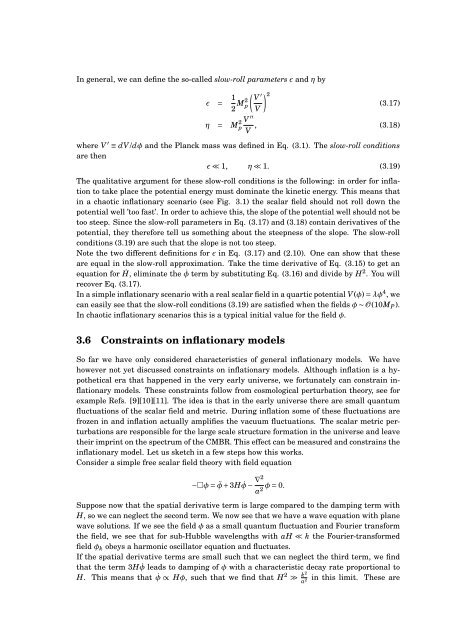Master's Thesis in Theoretical Physics - Universiteit Utrecht
Master's Thesis in Theoretical Physics - Universiteit Utrecht
Master's Thesis in Theoretical Physics - Universiteit Utrecht
You also want an ePaper? Increase the reach of your titles
YUMPU automatically turns print PDFs into web optimized ePapers that Google loves.
In general, we can def<strong>in</strong>e the so-called slow-roll parameters ɛ and η byɛ = 1 2 M2 p( V′) 2(3.17)V ′′Vη = M 2 pV , (3.18)where V ′ ≡ dV /dφ and the Planck mass was def<strong>in</strong>ed <strong>in</strong> Eq. (3.1). The slow-roll conditionsare thenɛ ≪ 1, η ≪ 1. (3.19)The qualitative argument for these slow-roll conditions is the follow<strong>in</strong>g: <strong>in</strong> order for <strong>in</strong>flationto take place the potential energy must dom<strong>in</strong>ate the k<strong>in</strong>etic energy. This means that<strong>in</strong> a chaotic <strong>in</strong>flationary scenario (see Fig. 3.1) the scalar field should not roll down thepotential well ’too fast’. In order to achieve this, the slope of the potential well should not betoo steep. S<strong>in</strong>ce the slow-roll parameters <strong>in</strong> Eq. (3.17) and (3.18) conta<strong>in</strong> derivatives of thepotential, they therefore tell us someth<strong>in</strong>g about the steepness of the slope. The slow-rollconditions (3.19) are such that the slope is not too steep.Note the two different def<strong>in</strong>itions for ɛ <strong>in</strong> Eq. (3.17) and (2.10). One can show that theseare equal <strong>in</strong> the slow-roll approximation. Take the time derivative of Eq. (3.15) to get anequation for Ḣ, elim<strong>in</strong>ate the ˙φ term by substitut<strong>in</strong>g Eq. (3.16) and divide by H 2 . You willrecover Eq. (3.17).In a simple <strong>in</strong>flationary scenario with a real scalar field <strong>in</strong> a quartic potential V (φ) = λφ 4 , wecan easily see that the slow-roll conditions (3.19) are satisfied when the fields φ ∼ O(10M P ).In chaotic <strong>in</strong>flationary scenarios this is a typical <strong>in</strong>itial value for the field φ.3.6 Constra<strong>in</strong>ts on <strong>in</strong>flationary modelsSo far we have only considered characteristics of general <strong>in</strong>flationary models. We havehowever not yet discussed constra<strong>in</strong>ts on <strong>in</strong>flationary models. Although <strong>in</strong>flation is a hypotheticalera that happened <strong>in</strong> the very early universe, we fortunately can constra<strong>in</strong> <strong>in</strong>flationarymodels. These constra<strong>in</strong>ts follow from cosmological perturbation theory, see forexample Refs. [9][10][11]. The idea is that <strong>in</strong> the early universe there are small quantumfluctuations of the scalar field and metric. Dur<strong>in</strong>g <strong>in</strong>flation some of these fluctuations arefrozen <strong>in</strong> and <strong>in</strong>flation actually amplifies the vacuum fluctuations. The scalar metric perturbationsare responsible for the large scale structure formation <strong>in</strong> the universe and leavetheir impr<strong>in</strong>t on the spectrum of the CMBR. This effect can be measured and constra<strong>in</strong>s the<strong>in</strong>flationary model. Let us sketch <strong>in</strong> a few steps how this works.Consider a simple free scalar field theory with field equation−□φ = ¨φ + 3H ˙φ −∇ 2a 2 φ = 0.Suppose now that the spatial derivative term is large compared to the damp<strong>in</strong>g term withH, so we can neglect the second term. We now see that we have a wave equation with planewave solutions. If we see the field φ as a small quantum fluctuation and Fourier transformthe field, we see that for sub-Hubble wavelengths with aH ≪ k the Fourier-transformedfield φ k obeys a harmonic oscillator equation and fluctuates.If the spatial derivative terms are small such that we can neglect the third term, we f<strong>in</strong>dthat the term 3H ˙φ leads to damp<strong>in</strong>g of φ with a characteristic decay rate proportional toH. This means that ˙φ ∝ Hφ, such that we f<strong>in</strong>d that H 2 ≫ k2a 2 <strong>in</strong> this limit. These are
















